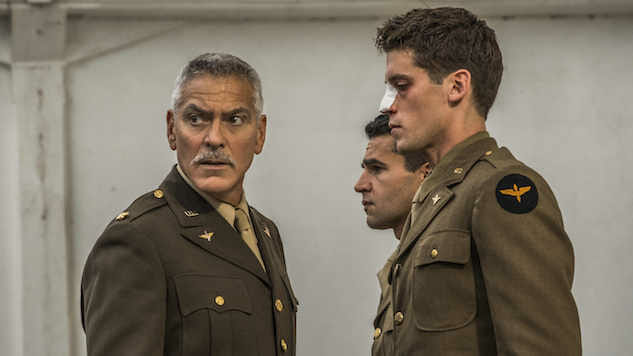7 Things You Need to Know About Hulu’s George Clooney-Produced Adaptation of Catch-22
Photo: Philipe Antonello/Hulu
Catch-22, author Joseph Heller’s sardonic novel about the absurdity of battles and casualties, is a cult hit that’s long been a key text of anti-war activists and required reading in many AP English literature classes. Now, Hulu is bringing a splashy limited series adaptation from George Clooney, Grant Heslov and others. Premiering May 17 on the streaming platform, the project aims to battle it out for awards consideration—and might even let the ER vet cross off the “E” in his EGOT.
Clooney, Heslov and more involved with the miniseries appeared as part of Hulu’s day at the Television Critics Association’s biannual press tour in Pasadena, Calif. to share some details about their take on Catch-22.
How do you tell such a complicated story as a TV show?
While Heller’s novel jumps around among different points of view, the miniseries traces a linear path, concentrating on Air Force bombardier John Yossarian (Girls’ Christopher Abbott).
Luke Davies, who shares writing credits with David Michôd, says that, for the character, “the world is in chaos around him” and that “there’s barely a single scene in the entire six hours in which Chris isn’t in it.”
How relevant is this story now?
Very relevant, the panel argues. Davies says that Heller’s book—which is set during World War II—is “a beautiful and hilarious novel about the relationship between war and insanity and capitalism and bureaucracy.”
He adds, “we all wake up every morning these days in a shared global anxiety condition. This is like the origin story of that.”
Grant Heslov cast himself in one challenging part.
Heslov, Clooney’s long-time producing partner, plays Doc Daneeka—the character tasked with explaining exactly what a Catch-22 is: “Orr was crazy and could be grounded,” as Heller writes. “All he had to do was ask; and as soon as he did, he would no longer be crazy and would have to fly more missions. Orr would be crazy to fly more missions and sane if he didn’t, but if he was sane he had to fly them. If he flew them he was crazy and didn’t have to; but if he didn’t want to he was sane and had to.” Heslov says that monologue was hard to get out, and that “as we got shooting, it became apparent to me that that’s an iconic scene.”
Are they concerned about competing with Mike Nichols’ 1970 film?